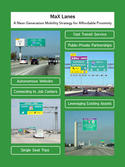Someone asked me to reconcile my recent paper on rail funding with my stance on Cal-Train electrification that the feds should prioritize funding towards poorer cities. Very good question because there is an apparent conflict there. read more »
Transportation
Rail in Legacy Cities vs. Federal Funds to Poorer Markets
- Login to post comments
Cincinnati Streetcars’ “Catastrophic Failures”
The Cincinnati streetcar–now known as the Cincinnati Bell Connector since Cincinnati Bell paid $3.4 million for naming rights–is barely six months old, and already is having problems. Four streetcars broke down in one day a few months ago. read more »
MaX Lanes: A Next Generation Strategy for Affordable Proximity
This is the introduction to a new report written by Tory Gattis of the Center for Opportunity Urbanism. Download the full report here.
The core urban challenge of our time is ‘affordable proximity’: how can ever larger numbers of people live and interact economically with each other while keeping the cost of living – especially housing – affordable? In decentralized, post-WW2 Sunbelt cities built around the car, commuter rail solutions don’t work and an alternative is needed, especially as we see autonomous vehicles on the horizon. read more »
- Login to post comments
Subsidies Haven't Increased Transit Ridership
In 2015, the American Public Transportation Association issued a press release whose headline claimed that transit ridership in 2014 achieved a new record. However, the story revealed that 2014 ridership was the highest since 1956. That’s no more a record than if it was the highest since 2013. read more »
- Login to post comments
Reason #1 to End Transit Subsidies: It’s the Most Costly Transportation We Have
Fifty-three years ago, the transit industry was mostly private and earned a net profit. Today, it’s almost entirely publicly owned, and subsidies have grown out of control. It’s time to take a stand and say all transportation subsidies are bad, but transit subsidies are the worst. read more »
- Login to post comments
Should Transit Fares Cover Operating Costs?
Maryland has long had a state law requiring transit systems to collect enough fares to cover at least 35 percent of their operating costs. While it is admirable to set a target, this particular target is disheartening for two reasons. read more »
Bay Area Residents (Rightly) Expect Traffic to Get Worse
In a just released poll by the Bay Area Council a majority of respondents indicated an expectation that traffic congestion in the Bay Area (the San Jose-San Francisco combined statistical area) is likely to get worse. read more »
- Login to post comments
Urban leaders should plan for the public transit of the future
Self-driving, automated cars are coming. There will be teething pains in many forms: Some people will want highly automated vehicles while others will fear them. Some will be privately owned, and others will be taxis and shuttles for use by different people every day. read more »
Transit Ridership Down 2.3% in 2016
With little fanfare, the American Public Transportation Association (APTA) released its fourth quarter 2016 ridership report last week. When ridership goes up, the lobby group usually issues a big press release ballyhooing the importance of transit (and transit subsidies). But 2016 ridership fell, so there was no press release. read more »
- Login to post comments
Taxpayers Need Protection from Dallas-Houston High Speed Rail Bailout? New Report
The proposed privately financed high-speed rail line from Houston to Dallas is projected to have a revenue shortfall of $21.5 billion in its first 40 years of operation. This is the conclusion of a Reason Foundation report by Baruch Feigenbaum, the Foundation’s assistant director of transportation policy (Texas High Speed Rail: Caution Ahead). read more »
- Login to post comments




















